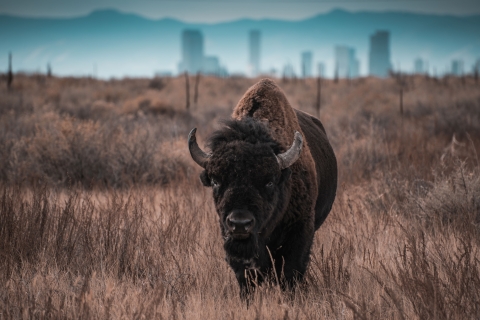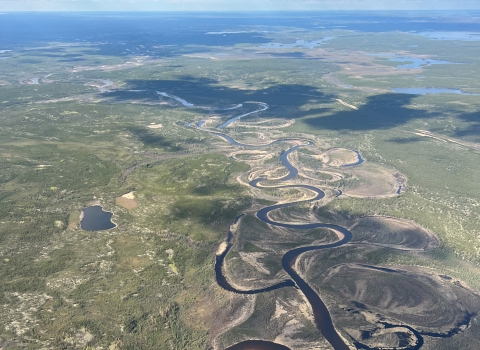Preparing for a stroll on a national wildlife refuge national wildlife refuge
A national wildlife refuge is typically a contiguous area of land and water managed by the U.S. Fish and Wildlife Service for the conservation and, where appropriate, restoration of fish, wildlife and plant resources and their habitats for the benefit of present and future generations of Americans.
Learn more about national wildlife refuge ? We got you.
One of the biggest reasons to visit a refuge is the chance to see wildlife — birds, bison, salamanders, you name it. National wildlife refuges are home to thousands of species. Whether you know it or not, wildlife need you to be responsible on your outdoor adventures. (Don’t worry. We promise you will still have fun).
Here are a few wildlife-friendly reminders for your next trip to a refuge — or any natural area.
The Basics
Know before you go. Plan ahead and become familiar with regulations and activities happening on the refuge. Know when and where activities like hunting or other special events are occurring. You may want to schedule your trip to avoid popular times.
Be respectful of other visitors. Sometimes, we can’t avoid times of high use. After all, the best times for wildlife viewing are reliant on the season and time of day. Remember, other visitors enjoy watching wildlife, too. Give others room and follow social distancing guidelines from the U.S. Centers for Disease Control.
Recreate responsibly during the COVID-19 pandemic.
Be a Good Steward
View from a distance. Give wildlife plenty of space. This is important for the animal's well-being and your safety. To view wildlife up close without disturbing it, use a zoom lens, binoculars or a spotting scope.
Do not disturb. Be respectful of nesting and denning areas. Avoid using amplified noises that may harm animals by frightening or misleading them. If you encounter wildlife (small or large), don’t touch — just enjoy the show. You may even see a sick or injured bird or animal. If you’re concerned, reach out to refuge staff.
Never feed wildlife. Feeding wildlife is dangerous for wildlife and people. Sharing your food can sicken an animal or encourage it to approach humans in the future, expecting a snack.
Leave pets at home. Bringing pets to refuges may be prohibited. Please check an individual refuge’s website to learn whether your pet can tag along. When welcome, pets are required to be on a leash. Regardless, leaving your furry companions at home may be a good idea because they may scare small animals or become prey for larger ones.
Pack it in. Pack it out. Whether it’s the wrapper from a snack or scraps of food, be sure to keep your trash and food waste with you to dispose of at home. Make sure to look over rest areas for accidental droppings — and collect them before leaving.
Leave No Trace. The phrase refers to a framework of seven principles that guide all adventurers to have a low impact while outdoors. Many of the tips we share on this page are variations of those seven principles.
Learn more about Leave No Trace.
Pro Tips
Wildlife Drive
Wildlife drives or auto tour routes on refuges offer a fun way to view wildlife from the safety and comfort of your vehicle. While driving, keep your eyes on the road and obey signs and speed limits. If you want to stop and snap a picture or focus in on a critter, pull your car completely off the road into a designated pullout to keep wildlife and other motorists safe.
Look Closely
Not all wildlife is easy to spot. Some fascinating creatures are smaller than a quarter. Look closely for pollinators and other insects that are vital to our ecosystem and critical for larger wildlife (and humans) to thrive. Native plants make great photo subjects.
Go With the Season
Want to see a cerulean warbler? In winter, you would need to book a flight to South America, or wait for spring in the United States. But that is no reason to be discouraged. Each season offers wildlife wonders to see. A pro tip? Become familiar with the migration seasons so you know what to expect on your visit. Take what the season will give you. (Hint: Visiting in the winter? Look for tracks in the snow. What about summer? Listen for the buzzing sounds of fascinating insects like dragonflies.)
Wondering what season fits your likings? Check out:
- Spring marvels on refuges
- Summer sights on refuges
- Fall wonders on refuges
- Winter scenes on refuges
This and That
Wondering what to bring?
- Water —Stay hydrated. Bonus points if you bring a reusable bottle.
- Sun protection —Those rays may be fiercer than you realize. Wear long-sleeve shirts, hats, sunglasses and sunscreen, no matter the season.
- Bug repellent — At certain times of the year, insects can be a nuisance. Be ready.
- Binoculars or spotting scope — This is a pro’s favorite. Binoculars and spotting scopes can help you see small and/or distant wildlife that would otherwise be easy to miss. Being able to see wildlife in detail from afar also will keep you safe.
- Camera — For most purposes, your phone will do. Take home the memories of your visit, share and tag us on Facebook or Twitter.
- Naturalist guide — This can be a brochure or even an app on your phone. Naturalist guides are a handy tool to help you identify birds and fauna alike.
- Journal — If sketching or writing is your thing, a journal can be a fun way to explore a refuge. Even if you aren’t the next Pablo Picasso or Maya Angelou, doodling and writing down observations and questions can be a fun way to learn your way around the trails.
Check out “How to Best Enjoy a National Wildlife Refuge” for more tips.
Where to Go?
Wildlife viewing doesn’t have to happen far from home. Most refuges are within 25 miles of a city or decent-size town. Find a refuge are near you. (Hint: National wildlife refuges are the best places for wildlife viewing.)




